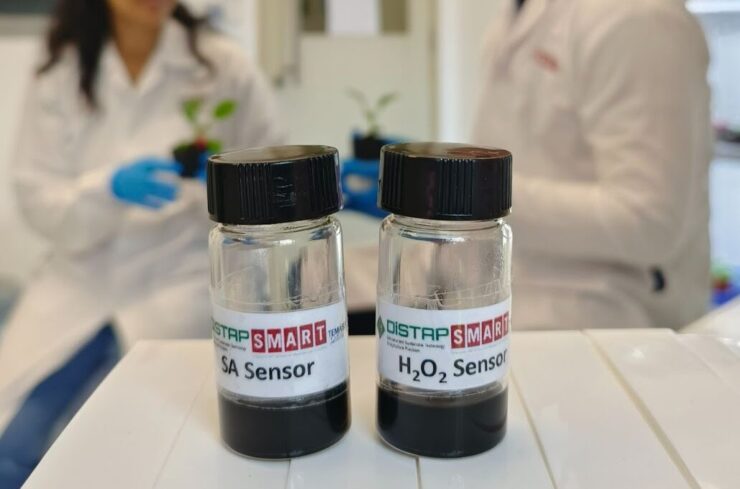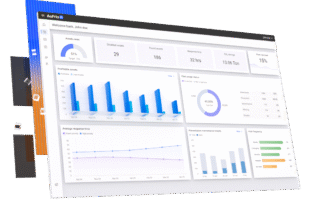
Courtesy of SMART
- This is the first highly selective nanosensor for salicylic acid – a plant hormone key in mediating plant stress response and adaptation – that has been validated in living plants
- This is also the first time different nanosensors for H₂O₂ and salicylic acid are combined, or multiplexed, for simultaneous and real-time monitoring of the distinct plant hormone profiles in the early stages of stress
- Leveraging the real-time insights from nanosensor multiplexing, researchers have formulated a mathematical model suggesting that early H₂O₂ waveforms vary according to specific stress types, thereby triggering distinct downstream signalling pathways within plants
Researchers from the Disruptive & Sustainable Technologies for Agricultural Precision (DiSTAP) Interdisciplinary Research Group (IRG) of Singapore-MIT Alliance for Research and Technology (SMART), MIT’s research enterprise in Singapore, in collaboration with Temasek Life Sciences Laboratory (TLL) and Massachusetts Institute of Technology (MIT), have developed a cutting-edge nanosensor that allows for the real-time monitoring of salicylic acid (SA) during the early stages of stress response.
SA is a crucial plant hormone for growth, development, and stress response to pathogens, temperature, drought, salinity, metals, UV light, and osmotic stress. The researchers also pioneered a method to multiplex, or combine, this sensor with others for simultaneous and real-time tracking of multiple plant hormone profiles and chemical signals.
This insight into the complex communication within stressed plants is vital in cultivating crops that are resilient to various stressors, including climate change. Traditional methods of stress detection in plants are reliant on laborious lab tests, time-consuming, and both destructive and disruptive to plant growth, while emerging technologies like chlorophyll fluorescence and hyperspectral imaging focus on the metabolic changes that occur when reparative measures are limited and only after the initial stress perception and signalling.
In a paper titled “Decoding early stress signalling waves in living plants using nanosensor multiplexing,” recently published in the Nature Communications journal, SMART researchers document their double breakthroughs in plant health monitoring. Firstly, the development of the first-ever nanosensor, validated in-planta in living pak choi (commonly known as Chinese cabbage), that specifically detects SA, a plant hormone key in mediating plant stress response and adaptation. Secondly, the researchers also pioneered a method to combine this sensor with others, paving the way for simultaneous and real-time tracking of multiple plant chemical signals and stress markers during early stress stages, which can, in turn, enable earlier diagnoses and, ultimately, improve plant stress tolerance and mitigate crop losses due to environmental stress.
This research and technology builds upon SMART DiSTAP’s long-standing body of work with innovative plant sensors based on the concept of corona phase molecular recognition (CoPhMoRe) pioneered by the Strano Lab at SMART DiSTAP and MIT. This includes a breakthrough by DiSTAP in 2021 in the development of the first-ever nanosensor to enable rapid testing of synthetic auxin plant hormones; followed by another world-first in 2023 with the first-ever nanosensor designed to detect and distinguish gibberellins (GAs) – a class of hormones important for plant growth. This success of the CoPhMoRe concept has now been further advanced with this latest development of a highly selective plant nanobionic sensor for SA through a distinct and unique process of design, synthesis and testing.
“This sensor for SA gives us insights into a new signalling language within living plants. Now, farmers can understand in real-time the specific types of stress and stressors affecting the crops,” shared Professor Michael Strano, corresponding author, DiSTAP Co-Lead Principal Investigator and Carbon P. Dubbs Professor of Chemical Engineering at MIT.
Emphasising the significance of monitoring SA levels in plants, Jolly Saju, Research Officer at TLL and co-lead author of the paper, shared, “Fluctuations in SA levels serve as early indicators of plant stress. By harnessing the power of plant nanobionic sensors designed specifically for detecting SA, farmers can now proactively measure stress levels in plants long before visible signs manifest. This invaluable data empowers farmers with the foresight needed to pre-emptively intervene and implement targeted measures to mitigate crop loss.”
To demonstrate the power of multiplexed sensors, the researchers paired the SA sensor with another designed to detect hydrogen peroxide (H₂O₂). They then exposed plants like pak choi to various stressors, including light fluctuations, extreme heat, pathogen attacks, and even mechanical wounding (physical damage to the plant mimicking insect bites). The results showed that each type of stress triggered a unique pattern of SA and H₂O₂ production response within the plant. This discovery offers a deeper understanding of how plants communicate and combat different stresses, paving the way for the development of crops with enhanced resilience. Ultimately, it contributes to a more secure global food supply in the face of challenges such as climate change.
“This groundbreaking technology represents a significant leap forward in plant stress detection and diagnosis,” said Dr Mervin Chun-Yi Ang, Principal Research Scientist at SMART DiSTAP and co-lead author of the paper. “By unlocking its full potential through sensor multiplexing, comprehensive data analysis and computational modelling, we envision a future where on-farm diagnostics can empower farmers to optimise crop health and resilience. This technology could potentially revolutionise urban agriculture, fostering a more secure and sustainable global food supply.”
“The ability to examine the activation and coordination of different signalling molecules simultaneously during plant stress responses will truly enhance our understanding of how plants react to stress and the mechanisms involved. The nanosensors are species-agnostic and can be used to study any commercial crop, providing new approaches to increase plant stress resilience in the face of climate change,” added Dr Rajani Sarojam, corresponding author, Senior Principal Investigator at TLL, and Principal Investigator at DiSTAP.
SMART DiSTAP is currently working on multiplexing various sensors to create a more comprehensive picture of plant stress. Future industry applications include the integration of such multiplexed nanosensors into particular plants within a batch of crops, turning these plants into sentinels for the entire batch by monitoring environmental variables, pathogens and stresses, and giving farmers real-time data on crop health.
The design and development of the nanosensors and formulation of the mathematical model decoding various plant stresses were done by SMART and MIT. TLL was responsible for the design, execution and analysis of plant-related studies, including the validation of nanosensors in transgenic plants. The research is carried out by SMART and supported by NRF under its Campus for Research Excellence And Technological Enterprise (CREATE) programme.








